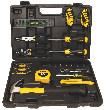Organizing the Kitchen Pantry
If you're fortunate enough to live in a home that affords a kitchen pantry, it is wise to use that space efficiently. I've lived in houses without a pantry and didn't know what I was missing until we bought a home with a large pantry. Thoroughly organizing a kitchen pantry involves categorizing, rotating stock, inventorying, and using appropriate food storage containers. Here are some great tips to follow to organize your kitchen pantry and make the best use of valuable space:
- Begin by taking everything out of your pantry and putting the items on your kitchen table or floor. Thoroughly clean your pantry shelves.
- Take a look at all of your items and sort them by their containers. Foodstuffs are sold in cans, boxes, bags, and sacks. Shift all of the canned items to one side of the table or floor, and all of the bagged, boxed, and sacked items to other sides of the work surface. Items also are produced in plastic, such as seasoned salt and spices. Make a space for those items, as well.
- Now that you've sorted them, categorize them by foodstuff. Start with the canned foods and group all of the soups together, then all of the fruits, coffee, then beans, et cetera. Do the same with your boxed foods such as toaster pastries, crackers, fruit snacks, and taco shells. Then continue with bagged items, such as chips, then sacked items, such as flour, corn meal, and sugar. Finish with small foodstuffs in plastic containers, such as garlic powder, drink mixes, and peanut butter.
- Transfer your dry staples such as sugar, flour, and corn meal to plastic containers with sealing lids. Place those containers on the floor of your pantry.
- Use your largest shelf for your canned goods, placing them in rows according to foodstuff, with the earliest date at the front of the pantry. Face the labels forward. If you have a lot of canned foods, use another shelf if you have the space. While you can stack canned foods, they are heavy and might break your shelving if you try to stack them.
- Place all of your boxed items on another shelf, grouping foodstuffs together. The next shelf should contain your bagged items, and another shelf will hold your small items produced in plastic containers.
When you buy new food, rotate your stock. Before you add new food to the pantry, pull your old food to the front, and place the new food behind. Check your dry staples periodically for bugs and replace those as necessary. Never leave open food in your pantry. Place cookies in cookie jar on your kitchen countertop, and clip shut your bags of chips.
Author Bio
April Reinhardt
An administrator for a mutual fund management firm, April deals with the written word daily. She loves to write and plans to author a memoir in the near future. April attended Morehead State University to pursue a BA degree in Elementary Education. Learn more about April...
Prom Fashion Basics for Guys
When you choose your tie, belt, socks, and shoes, make sure that those accessories compliment your outfit, as well as ...
Discover More
Getting Rid of Fleas without Chemicals
Most of us have seen fleas, especially if you've owned a dog or cat, or have visited family or friends who own dogs or ...
Discover More
Silicone Cookware
Unlike metal bake ware that rusts, and glass cookware that breaks, silicone cookware is lightweight, easy to handle, and ...
Discover More
Organize Your Shopping List
Shopping lists are great tools, as long as they are prepared correctly. Here is a simple way to make the best possible ...
Discover More
Keeping Your Kitchen Gadgets Organized
Keeping gadgets organized can be a tedious task especially when you need to put away small kitchen gadgets you do not use ...
Discover More
Effective Kitchen Organization
Stress-free meal preparations can be a reflection of how organized your kitchen is designed. Create an inviting cooking ...
Discover More

Comments